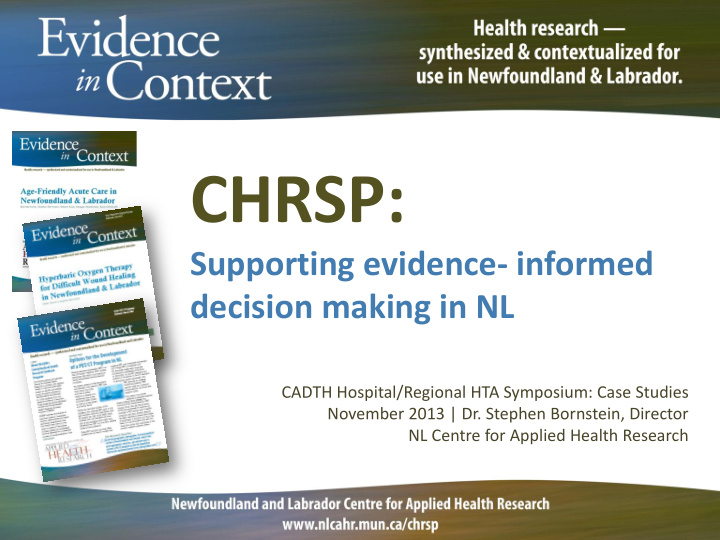



CHRSP: Supporting evidence- informed decision making in NL CADTH Hospital/Regional HTA Symposium: Case Studies November 2013 | Dr. Stephen Bornstein, Director NL Centre for Applied Health Research
CHRSP: C ontextualized H ealth R esearch S ynthesis P rogram
Features A unique approach to decision support in NL • Scope: the province • Subjects: HTA broadly conceived • Meta-Review Methodology • Full engagement of stakeholders • Contextualization is the key
Background • CCOTHA-funded executive training program in use of HTA reports produced a consensus: o Context is crucial; we should do our own HTA o We can’t; so let’s synthesize other HTAs and contextualize them • Add a methodological insight from Manitoba CHP • The result? CHRSP
Western DHCS Health Integrated Eastern NLCAHR Health KTE Labrador Central Grenfell Health Health
Contextualization CHRSP tailors its syntheses to the context of Newfoundland CHRSP identifies & Labrador at all stages of the project contextual factors. Contextual factors effect health CHRSP interprets findings in context. outcomes and/or cost effectiveness: Patient populations Other System Factors Labrador Grenfell Health Site of service Economics and/or the service design , Topics of Health human resources Politics relevance Central Health Organization and delivery More about context here: www.nlcahr.mun.ca/research/chrsp/ of services Eastern Health
CHRSP in a nutshell • Ongoing, structured partnership at peak level • Iterative process of topic development/ selection • Literature search and specialist-led synthesis • Specialized teams for each project • Timing • New accelerated version (Rapid Evidence Reports)
CHRSP Projects 2008-2013 • Developing a PET/CT program in NL • Reprocessing/reuse of single-use medical devices • Dialysis services in rural and remote NL • How to prevent/treat childhood overweight and obesity in NL • Youth residential treatment options in NL • Hyperbaric oxygen therapy for problem wounds • Telehealth for specialist consultations in cardiology and dermatology • Inter-professional care for chronic disease management • Age-friendly acute care • Community-based service models for seniors • Mobile mental health units for Western Health (RER) • Safe patient handling for Eastern Health (RER)
CHRSP Projects Pending Currently in progress: • Point-of-Care Testing -EIC • Falls Prevention for seniors in LTC/acute care settings- EIC • Flu Vaccination for healthcare workers -RER Other projects identified in 2013 Topic Selection: • Effectiveness of short-term health promotion strategies - RER • Outpatient chronic disease services – RER • Diabetes screening • Managing aggression in dementia patients
PET CT Given the geographic, demographic, fiscal and political context of Newfoundland and Labrador, what is the most appropriate, effective, and efficient way to operate a PET/CT program so that the population derives the maximum benefit at the best possible cost? Audience Deputy Minister of Health and the CEOs of the province’s four RHAs Committee at Eastern Health Issues Additional costs required Location and use of scanner Considerations Could a PET scanner operate effectively without a local cyclotron? Decisions Require PET scanner and cyclotron Doubling the costs Significant staffing and training requirements Report consulted in committee deliberations towards the acquisition and implementation of a scanning program
Single-Use Medical Devices What does the best currently available scientific evidence say about the effectiveness, safety, and potential economic benefits of reusing certain reprocessed single-use devices (SUDs)? Audience Deputy Minister of Health and the CEOs of the province’s four RHAs Senior decision makers in NL health system Issues Safety-- do reprocessed devices increase risk of infection or breakdown? Costs -- reprocessing and reusing single-use devices was seen as having the potential of saving money as compared to purchasing new devices. Considerations What formal policies were in place in NL institutions? What procedures were actually being practiced? What did the evidence said about safety and reliability of single-use devices? Decisions Some NL health authorities did not have a formal policy in place and, in others, actual practice differed from formal policy forbidding reprocessing and reuse; the evidence in the AETMIS report was clear and straightforward; the result was the adoption of a formal no-reuse policy in the RHA that had no policy and, supposedly, a shift in practice across the province towards no-reuse.
Does CHRSP Really Work? • topic selection complex but workable • contextualization is feasible and essential for interest and uptake • teams work well together • results can be produced fairly quickly • results have actually been used: o Considerations for development of PET-CT o Single-use Medical Devices policy o Dialysis decision template o Patient handling protocols in Eastern Health
More recommend